City Council reviews pedestrian connection proposal amid wetland concerns
January 13, 2025 | Boulder, Boulder County, Colorado
This article was created by AI summarizing key points discussed. AI makes mistakes, so for full details and context, please refer to the video of the full meeting. Please report any errors so we can fix them. Report an error »

In a pivotal Boulder City Planning Board meeting, members engaged in a heated discussion about the importance of establishing pedestrian and bicycle connections in new developments. The conversation highlighted the long-term impact of these connections, with one board member emphasizing that any infrastructure built today could last for up to a century. "Whatever is built here will be here for 100 years probably, 50 years easily," they stated, underscoring the necessity of planning for future connectivity.
The board debated the feasibility of incorporating these connections, particularly in light of potential wetland areas and ADA compliance. One member proposed modifying the motion to ensure that any required connections would be subject to staff evaluation, allowing for flexibility if environmental or accessibility issues arose. "If we can't do it because of wetland criteria or because it's physically impossible... then the language should allow an out," they argued.
The discussion also touched on the need for coordination with neighboring sites, as existing connection plans could influence the current development. A suggestion was made to revise the motion to reflect staff recommendations, which would provide a clearer path forward for the applicants while ensuring that necessary evaluations are conducted.
As the meeting progressed, board members expressed support for the revised language, indicating a collective desire to balance development needs with environmental considerations. The outcome of this discussion could significantly shape Boulder City's approach to urban planning, emphasizing the importance of connectivity in fostering a more accessible community.
The board debated the feasibility of incorporating these connections, particularly in light of potential wetland areas and ADA compliance. One member proposed modifying the motion to ensure that any required connections would be subject to staff evaluation, allowing for flexibility if environmental or accessibility issues arose. "If we can't do it because of wetland criteria or because it's physically impossible... then the language should allow an out," they argued.
The discussion also touched on the need for coordination with neighboring sites, as existing connection plans could influence the current development. A suggestion was made to revise the motion to reflect staff recommendations, which would provide a clearer path forward for the applicants while ensuring that necessary evaluations are conducted.
As the meeting progressed, board members expressed support for the revised language, indicating a collective desire to balance development needs with environmental considerations. The outcome of this discussion could significantly shape Boulder City's approach to urban planning, emphasizing the importance of connectivity in fostering a more accessible community.
View full meeting
This article is based on a recent meeting—watch the full video and explore the complete transcript for deeper insights into the discussion.
View full meeting
